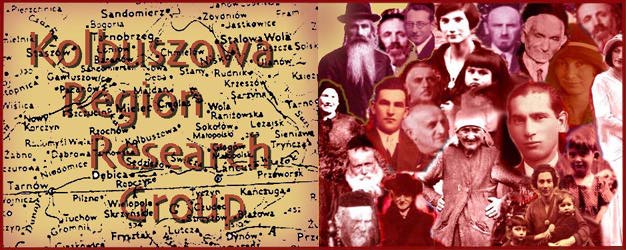


The Jews of Grodzisko Dolne
Written by Violetta Reder
Grodzisko acquired municipal law in 1740. Jews were among the town’s first settlers in the second half of the 18th c., and the kahal functioned since the beginning (in 1754, they had a synagogue and a cemetery). The Bishop of Przemyśl, Wacław Sierakowski (1741 – 1760), demanded that the prayer house should be closed down as it had been built without his permission.
In 1891, the autonomy of the Jewish kahal in Grodzisko was liquidated, and its Jews became subjected to the kahal in Leżajsk, but, in Grodzisko, they had synagogue, a mikva, a kosher butchery, two cheders in 1880’s (with 22 boys) and three cheders in 1920’s (with 85 boys), they also used their cemetery. A flu epidemic claimed many lives in 1918, and later in that year peasants staged a pogrom destroying much property. In 1921, in Grodzisko Miasteczko (Grodzisko Shtetl), there were 367 Jews (62,3 % of the population). That number was decreasing between the World Wars because of the poor economic conditions and the consequent migrations of Grodzisko Jews to big cities like Lvov, Kraków, Rzeszów, Przemyśl and abroad. In 1930, Grodzisko Miasteczko became included in Grodzisko Dolne. In 1935, Grodzisko Dolne was inhabited by 442 Jews who continued to live within Grodzisko Miasteczko. Around the market and the streets there were 70 wooden houses with 82 Jewish families involving in all kind of trade and craft.
The local synagogue stood at the top of the hill where the streets of the Grodzisko shtetl met. The synagogue was described by Ilex Beller in his book and presented in his paintings. It was a two level building made of carved wood covered with a zinc roof, with two rows of small square windows. It presented big artistic value. The elapsing time changed the light grey colour of the building into brown. The interior was colourful and lit by a copper chandelier. The arches of the ceiling had softly carved and gilded decorations. The ceiling paintings showed flora and animals symbolizing the Twelve Tribes of Israel. The synagogue was opened for shabbats and festivals, while the prayer house, which was close to it, was open day and night. Hasids would come here to pray in the morning and in the evening, and also before their work. Young Talmudist (15-16 years old) would study the books here all day long – they had too much knowledge to attend a heder, but they were too poor to continue education at a rabbinic school in a big city.
From 1909 Eliezer Horowitz (1881–1943) was rabbi and tzaddik in Grodzisko. Later, he moved to Tarnów and was killed by the Nazi.
After the town was occupied by the Nazi on September 27th, 1939, part of the local Jews were expelled beyond the San river - into the Soviet-occupied part of Poland. The Jewish residents were expropriated on September 12th, 1941. The synagogue was pulled down by the Nazi and the cemetery was almost completely devastated. Since that time most of the Jewish houses were pulled down and new houses were built. Under "Photos and Postcards" on this webpage, we submitted a 2008 photo of Fingerhut’s house which stood close to the synagogue - and a 2010 photo of the gap remaining after a pull-down
The ghetto, established in 1941, enclosed 750 Jews, most of whom were brought from outside the town. During the liquidation of the Grodzisko Ghetto, the 21 year old German Gestapo member, Adolf Jeske, executed 241 Jews from Grodzisko Dolne and Tryńcza, who became buried in a common grave at the local cemetery. Witness of this tragic event has been given by the local Polish resident who was forced to bury the bodies – Jan Chmura. The Archives of the District Commission for the Investigation of German Crimes in Poland (OKBZH) in Rzeszów keep a file titled “Śledztwo w sprawie Adolfa Jeske” (“Inquiry into the case of Adolf Jeske”; index number: I.S.9/72). The victims’ list, included in that file, is published at our webpage for the first time ever. So far, there is not a single plaque or mark at the Grodzisko cemetery saying that the 241 persons, known by name, have died a tragic death and are lying there.
In 1983, a well-known painter, Chaim Ilex Beller, visited his family shtetl, Grodzisko Dolne for the first time. In 1997, a distinguished Polish film director, Jacek Gąsiorowski, presented Beller in a famed film “Miasteczko” (“The Shtetl”), including also the local people’s recollections of Jews in Grodzisko, and showing the mutual interreligious relations among its inhabitants in the past.
Violetta Reder
Bibliography:
1. I. Beller,
Ils Ont Tué Mon Village: Main Schtetl, Paris 1981.
2. I. Beller, Life in the Shtetl, New York 1986.
3. M. Kuźma,
http://www.sztetl.org.pl/pl/article/grodzisko-dolne/5,historia/, 30.XI.2010.
4. A. Potocki, Śladami chasydzkich cadyków w Podkarpackiem (“Following
the Footsteps of the Hassidic Tsaddikim in the Subcarpathian Region”), Rzeszów
2008, pp. 54-55.
5. S. Spector, G. Wigoder (ed.), “Grodzisko” in: The Encyclopedia of Jewish
Life Before and During the Holocaust, Vol. 1, New York 2001.
© Copyright 2017 Kolbuszowa Region Research Group. All rights reserved.